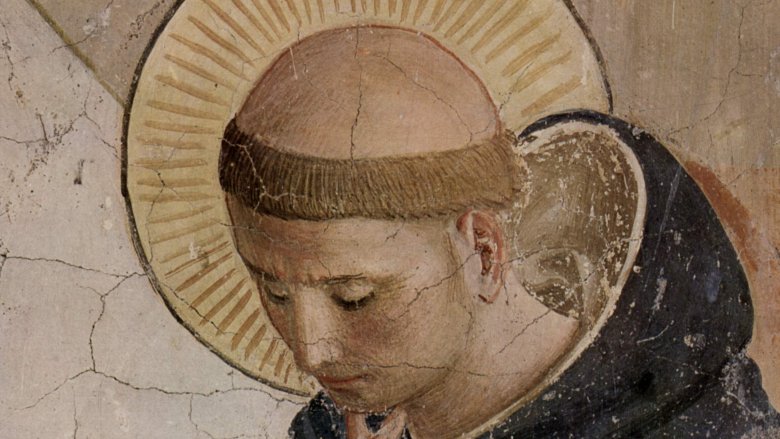The Real Reason Monks Had That Haircut
There are few hairstyles as distinctive as the Christian monks' tonsure. When you see someone sporting the shaved head with the ring of hair, there's absolutely no doubt about what vocation the wearer has chosen. But why on earth did such a strange haircut evolve in the first place?
The term "tonsure" is actually a reference to any religious or ceremonial clipping of hair. It's usually done to mark a stage in some kind of religious journey, and it's practiced in religions including Christianity, Eastern Orthodoxy, Buddhism, Hinduism, and it was even done in ancient Greece and Rome (via Britannica). And it's in Rome that the story of the Christian tonsure starts.
According to the Encyclopedia of Hair: A Cultural History, it's unclear just when Catholic monks started adopting the trend of shaving the tops of their heads while leaving that little ring of hair. Historians do think it started around the same time men started organizing into devout communities of monks, which places the time frame around the second or third century A.D. There are a few reasons why early monks might have chosen to go for this sort of look, and one is that it had long been traditional to completely shave the head of slaves to denote their low status. Early monks styled themselves as "slaves of Christ," and the tonsure might have been a way to demonstrate their obedience to the divine.
There's another theory, too, and this one comes from Daniel McCarthy, a scholar in Dublin who has done a ton of research on the use of the tonsure. He says the distinctive hairstyle was a tribute to the crown of thorns placed on Christ's head during the crucifixion.
When men decided to enter the community, the first haircut they got wasn't the tonsure — it was just an incredibly short haircut done with scissors. The tonsure was reserved for marking the occasion of the novice taking his vows to become an actual monk, and monasteries had barbers who were responsible for maintaining the look. Straightforward enough, but if there's anything that's guaranteed about history and religion, it's that nothing is ever straightforward.
The tonsure that gets featured in all kinds of movies is actually one of three different styles. The one that everyone knows is called the Roman or St. Peter's tonsure, while some monks — particularly devotees of St. Paul — chose to shave their entire heads in what's called an eastern style.
Then, there was a Celtic or Simon Magus tonsure. Like the name suggests, it was common in the British Isles and Ireland, but its exact characteristics are debated. Some say Celtic monks would shave the fronts of their heads from ear-to-ear while leaving the rest long, while McCarthy's research suggests heads were shaved to include a fringe across the front. No one is completely sure because the Celtic tonsure was outlawed in 664.
According to Kaliaperumal Karthikeyan of the Sri Manakula Vinayagar Medical College, Celts had been sporting the tonsure well before they met anyone who ever called themselves Roman. There was no religious belief or basis for the head-shaving (that historians have been able to determine), and when Christianity came to the Celts, they decided to keep wearing their tonsures in the same way they always had.
McCarthy says that was a huge problem for a few different reasons, and the church's outrage over this different hairstyle was so great there was call for clerics who wore it to be excommunicated.
English Heritage says the different monks' tonsures were a visible sign of something the Christian church absolutely didn't want: different views not just on hair, but on other traditions, too. The bigger point of contention was how the date for Easter was figured out each year. Both traditions used the lunar cycle to find the date, but the methods were so different that the Roman and Celtic dates could be as far as a month apart. And it wasn't just a few people following one tradition or the other — even royal households were divided down the middle.
This was a huge deal, and as Bede put it in his eighth-century writings, "This dispute rightly began to trouble the minds and consciences of many people, who feared that they might have received the name of Christian in vain."
They couldn't be having that, so in 664 the two factions met at Whitby. They presented their cases to the king, who chose to follow the Roman faction and outlaw the Celtic tonsure in favor of the St. Peter's tonsure. Why? Because of the answer to one simple question: "Who is the gatekeeper of heaven?"
For the next 1,300 years, monks following accepted church tradition shaved their heads in the style of St. Peter. It wasn't until 1972 that Pope Paul VI ordered the hairstyle to relax a little (via the New York Times), declaring that those studying to be priests no longer had to shave their heads (but could if they wanted to). The reason? It was described as an "empty ceremony," and some church leaders even suggested the hairstyle might have been making some rethink entering the priesthood.
